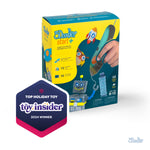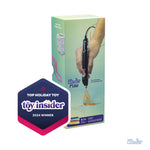Doodle Magic Words
In this lesson, students will work with a partner to doodle a list of spelling words written on paper cards. Students will peel off the letters, shake them up in a cup, spill the letters on a desk, and arrange the letters to spell words. In the second half of this lesson, students will toss all of their letters into a cup, spill them onto a desk to create and record as many words as they can. This lesson contains words from the Dolch Sight Word Website, however, the teacher may substitute his or her own spelling list.

KnowledgeStudents havehad practice with spelling the words used in this lesson, e.g., always, around, found, been, before, best, both, buy, call, cold.
had practice doodling lines and letters.
had practice with spelling the words used in this lesson, e.g., always, around, found, been, before, best, both, buy, call, cold.
had practice doodling lines and letters.
ObjectivesStudents willcreate a tactile system for recognizing and spelling words.
doodle spelling words using word-card stencils. *optional: doodle a magic-spelling wand.
rearrange scrambled letters to spell words.
use all letters to create a list of new words.
create a tactile system for recognizing and spelling words.
doodle spelling words using word-card stencils. *optional: doodle a magic-spelling wand.
rearrange scrambled letters to spell words.
use all letters to create a list of new words.
MaterialsStudents will need3Doodler (1 per pair)
Magic Spell-Spelling Worksheet (1 per pair)
Magic Spill and Spell Poem (1 per pair)
Magic Wand Stencil (1 per pair)
Paper or plastic cup (1 per pair)
3Doodler (1 per pair)
Magic Spell-Spelling Worksheet (1 per pair)
Magic Spill and Spell Poem (1 per pair)
Magic Wand Stencil (1 per pair)
Paper or plastic cup (1 per pair)
Lesson PlanInstructions
Step 1Whole group: Review the spelling list. The teacher may customize the spelling list or use the one provided in this lesson, i.e, always, around, found, been, before, best, both, buy, call, cold.
Step 2Project your computer or tablet screen on the board for students to view the Magic Spell-Spelling Worksheet. Spell each word together for practice.
Step 3Share the goal: Students will cut apart words on the Magic Spell-Spelling Worksheet. Students will use a 3Doodler to doodle the letters in each word. *Note that students should doodle one word at a time and place the words' letters in a neat pile. They should end up with 10 piles. Students will shake up the letters of one word in a cup and then "magically" unscramble the letters to spell the original spelling word.
Step 4Share the Magic Spill and Spell Poem with students.
Step 5 - OPTIONALDemonstrate how to doodle a Magic Spelling-Spell Wand using the stencil. Students may personalize their wands with embellishments. Students may make up their own silly magic word-spell.
Step 6Remind students to doodle each word (one at a time). Peel the doodled-letters off of one of the word cards, shake the letters up in a cup, wave the magic wand, say the magic words and then rearrange the letters to spell the word correctly. Partners should check each other's spelling. Repeat for all 10 words.
Step 7Divide students into pairs. Hand out 3Doodlers and Magic Spell-Spelling Worksheet.
Step 8Circle to assist and assess as students doodle and play.
Step 9After a sufficient amount of practice time, challenge students to place the letters from all 10 words together into a cup, shake it up, spill the letters out, and arrange letters to spell as many new words as possible.
Whole group: Review the spelling list. The teacher may customize the spelling list or use the one provided in this lesson, i.e, always, around, found, been, before, best, both, buy, call, cold.
Project your computer or tablet screen on the board for students to view the Magic Spell-Spelling Worksheet. Spell each word together for practice.
Share the goal: Students will cut apart words on the Magic Spell-Spelling Worksheet. Students will use a 3Doodler to doodle the letters in each word. *Note that students should doodle one word at a time and place the words' letters in a neat pile. They should end up with 10 piles. Students will shake up the letters of one word in a cup and then "magically" unscramble the letters to spell the original spelling word.
Share the Magic Spill and Spell Poem with students.
Demonstrate how to doodle a Magic Spelling-Spell Wand using the stencil. Students may personalize their wands with embellishments. Students may make up their own silly magic word-spell.
Remind students to doodle each word (one at a time). Peel the doodled-letters off of one of the word cards, shake the letters up in a cup, wave the magic wand, say the magic words and then rearrange the letters to spell the word correctly. Partners should check each other's spelling. Repeat for all 10 words.
Divide students into pairs. Hand out 3Doodlers and Magic Spell-Spelling Worksheet.
Circle to assist and assess as students doodle and play.
After a sufficient amount of practice time, challenge students to place the letters from all 10 words together into a cup, shake it up, spill the letters out, and arrange letters to spell as many new words as possible.
Wrap Up
Assessment
Possible Extensions
Resources
Vocabulary
antonym - a word opposite in meaning to another.
art - the quality, production, expression, or realm, according to aesthetic principles, of what is beautiful, appealing, or of more than ordinary significance.
categorize - to arrange in categories or classes; classify.
collaboration - to work jointly with others or together especially in an intellectual endeavor.
creative thinking - a way of looking at problems or situations from a fresh and imaginative perspective.
design - to prepare the preliminary sketch or the plans (for a work to be executed), especially to plan the form and structure of an object, building, bridge, etc...
drawing - the art or technique of representing an object or outlining a figure, plan, or sketch by means of lines.
language arts - the subjects (such as reading, spelling, literature, and composition) that aim at developing the student's comprehension and capacity for use of written and oral language.
literacy - the quality or state of being literate.
problem-solving - the process or act of finding a solution to a problem.
reading - the form or version of a given passage in a particular text.
sight words - commonly used words that young children are encouraged to memorize as a whole by sight, so that they can automatically recognize these words in print without having to use any strategies to decode.
spelling - the manner in which words are spelled.
synonym - a word having the same or nearly the same meaning as another in the language, as happy, joyful, elated. A dictionary of synonyms and antonyms (or opposites), such as Thesaurus.com, is called a thesaurus.
vocabulary - the stock of words used by or known to a particular people or group of persons.
Educational Standards
Demonstrate command of the conventions of standard English capitalization, punctuation, and spelling when writing.
Students will unscramble letters to spell words.
Read common high-frequency words by sight (e.g., the, of, to, you, she, my, is, are, do, does).
Students will recognize and read words from spelling list.
Decompose (break down) a larger problem into smaller sub-problems with teacher guidance or independently.
Students will break down the process of practicing spelling words into a tactile activity of doodling and arranging scrambled letters.
Use technology to seek feedback that informs and improves their practice and to demonstrate their learning in a variety of ways.
Students will use a 3Doodler to create a tactile model of spelling words.
Create original works or responsibly repurpose or remix digital resources into new creations.
Students will doodle letters and a magic wand.
Use collaborative technologies to work with others, including peers, experts or community members, to examine issues and problems from multiple viewpoints.
Students will confer with a partner and the whole group throughout this activity.





